Following the transaction that sent reigning batting champion Arraez to Miami, the Twins named López as their Opening Day starter. López finished seventh in the AL Cy Young voting after four strong starts and a four-year, $73 million contract extension. Churio and Salas were both bright prospects who were not expected to be included in the deal, though it’s unclear whether either will make it to the big leagues. Arraez earned his second straight hitting title and finished sixth in the voting for the 2023 NL MVP. He’ll be under team management in Miami until 2025.
Maeda finished second in the 2020 Olympics. Despite receiving Cy Young votes during the truncated season, he struggled in 2021, underwent Tommy John surgery, and re-established himself in 2023, though not without ongoing injury worries. The Twins were aware of his elbow troubles at the time of the transaction. When healthy, Graterol has been a reliable presence in the Los Angeles bullpen. Camargo has yet to reach the majors, and the Twins dealt Raley to the Rays. This transaction also included a second-round pick for Los Angeles.
4/7/22: Minnesota acquires Chris Paddack* (27.1 IP, 95 ERA+, 0.2 bWAR), Emilio Pagán (132.1 IP, 112 OPS+, 0.9 bWAR), Brayan Medina (has not reached Minnesota) from San Diego for Taylor Rogers (41.1 IP, 87 ERA+, -0.2 bWAR), Brent Rooker (7 PA, -100 OPS+, -0.2 bWAR), +1.1 bWAR for Minnesota.
Rogers, the Twins’ top reliever, was shipped to San Diego in this notorious deal. Rooker, a depth outfielder, only appeared in seven games for the Padres but was named a 2023 All-Star by Oakland.
In exchange, the team obtained Paddack, who had known elbow concerns and threw well in five starts before undergoing Tommy John surgery. He returned to the bullpen late in 2023 and will most likely begin 2024 in the starting rotation. Pagán struggled as a high-leverage reliever through 2022, but he had a sub-3.00 ERA and led the bullpen in innings in 2023. Medina is currently a starter in Rookie ball, and the Twins kept the majority of Rogers’ money.
3/12/22: Minnesota acquires Isiah Kiner-Falefa (did not reach Minnesota), Ronny Henriquez (11.2 IP, 173 ERA+, 0.2 bWAR) from Texas for Mitch Garver (559 PA, 121 OPS+, 2.5 bWAR), -2.7 bWAR for Minnesota.
Coming out of the lockout, Minnesota executed a deal that hit two birds with one stone: they secured a return for the injured Garver while also filling a vacancy at shortstop. Garver has suffered with injuries in Texas but has continued to hit well despite being limited to DH duties. Kiner-Falefa was a Twin for one day before being traded, and Henriquez pitched a few innings in 2022 before being released by the Twins following the 2023 season.
11/18/22: Minnesota acquires Alejandro Hidalgo (has not reached Minnesota) from Los Angeles (AL) for Gio Urshela (130 PA, 84 OPS+, 0.2 bWAR), -0.2 bWAR for Minnesota.
During his year in Minnesota, Urshela became a fan favorite and a reliable performer. He would, however, have been non-tendered in arbitration to avoid a perceived logjam in the Minnesota infield. He played all over the infield for the Angels and was somewhat productive before a broken pelvis terminated his season. Hidalgo is still a 20-year-old starter in High-A.
2/5/21: Minnesota acquires Shaun Anderson (8.2 IP, 47 ERA+, -0.5 bWAR) from San Francisco for LaMonte Wade Jr.* (1151 PA, 112 OPS+, 3.9 bWAR), -4.4 bWAR for Minnesota.
In retrospect, this was an unintentional error. The Twins had two similar alternatives for their fourth outfielder heading into 2021, Wade and Jake Cave, and they chose to trade Wade, who has been a steady presence in the Giants lineup when healthy. Cave struggled in his final two years in Minnesota, and Anderson, the AAAA lottery ticket they obtained for Wade, was out before the end of the year.
Total WAR gained: -8.8 bWAR
Unfortunately, by WAR, the Twins have given up more than they’ve brought in in MLB-for-MLB trades. However, there’s room for discussion. The team could say that they’d do the Donaldson, Arraez, and Graterol trades, even though they have not shown favorably by WAR, given the context of the trades. I said at the beginning that it’s easy to see who wins and loses, but it’s a little trickier to contextualize them.





